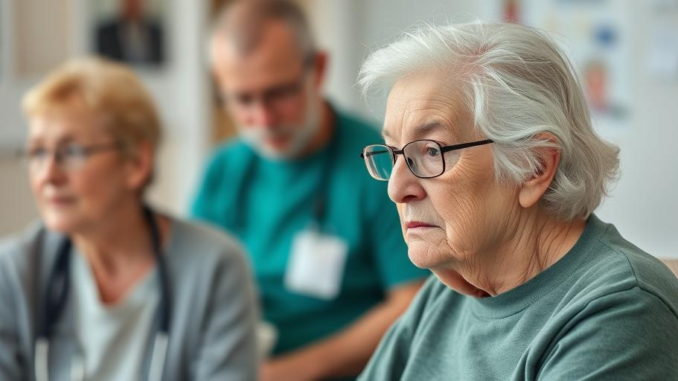
Summary
This article explores the intersection of geriatric care and emerging infectious diseases, focusing on a recent mystery illness in Congo, a new bat coronavirus, and Pope Francis’s pneumonia. It highlights the vulnerability of older adults to novel pathogens and underscores the importance of robust public health infrastructure and advanced medical care in protecting this population. The piece also touches upon the ongoing evolution of geriatric care and its adaptability to new health challenges.
** Main Story**
Okay, so, geriatric care, it’s always changing, isn’t it? We’re constantly seeing new challenges pop up, new breakthroughs happening. Think about it: just recently, there’s been that crazy illness in Congo, all the buzz about this new bat coronavirus, and even Pope Francis dealing with pneumonia. It really drives home how vulnerable older folks can be to these new diseases, you know? And it highlights how much we need a strong public health system and top-notch medical care.
That Mystery Illness in Congo
What’s happening in Congo is a real wake-up call. Over 50 people have died, and the disease progresses so fast, often within 48 hours. Plus, the symptoms – vomiting, diarrhea, body aches, and that awful internal bleeding – point to hemorrhagic fever. It’s scary stuff, and the possible link to eating bats just shows the danger of zoonotic diseases. The fact that even children are among the victims? It underscores the critical need for rapid response and effective public health measures in these regions, doesn’t it? It’s heartbreaking, really.
A New Bat Coronavirus – Should We Worry?
And then you’ve got this new coronavirus, HKU5-CoV-2, found in bats. Naturally, everyone gets a little jumpy when they hear ‘coronavirus’ these days. Though, the CDC says there’s no direct threat to humans… yet. It can infect human cells in a lab, but no actual human infections have been reported. Still, it’s a reminder that we need to keep a close watch and do the research to understand these potential threats. Being able to quickly assess the risks from new viruses? That’s key to being prepared. Constant monitoring and research, that’s how we stay one step ahead.
Pope Francis and Pneumonia
Remember when Pope Francis, at 88 years old, battled double pneumonia? It really showed both how resilient older adults can be and how far geriatric care has come. His treatment, which included respiratory physiotherapy, oxygen, and meds, shows what modern medicine can do. You can’t deny that, and you have to recognize its importance in this situation. And his recovery, even though it was gradual, highlights the importance of access to quality healthcare, personalized treatment, and continuous monitoring. Plus, he was still working during hospitalization. It’s a testament to the strength and adaptability of so many older adults, even when they’re facing serious health issues. Makes you think, doesn’t it?
What Does the Future Hold for Geriatric Care?
So, all of this points to where geriatric care needs to go, especially with these emerging diseases. We’re all interconnected now; diseases spread fast. Older adults, with their weaker immune systems and often pre-existing conditions, are at a greater risk. So what should we do? We need to be proactive. We should strengthen our public health systems, invest in research for new diagnostics and treatments, and promote healthy aging to boost immune resilience. It’s clear that the future of geriatric care will require ongoing innovation and adaptability. But hey, if you ask me, it’s a challenge worth tackling to protect the well-being of our older population.


Considering the vulnerability of older adults to zoonotic diseases, like the mystery illness in Congo, what preventative measures beyond public health infrastructure could be implemented to reduce exposure risks, particularly in regions with close human-animal interaction?
That’s a great question! Thinking beyond infrastructure, perhaps community-based education programs focusing on safe animal handling and hygiene practices could make a real difference. Also, exploring alternative livelihoods that reduce reliance on hunting could be beneficial. What are your thoughts?
Editor: MedTechNews.Uk
Thank you to our Sponsor Esdebe
“Mystery illness in Congo? Internal bleeding and linked to eating bats? Is that like a global warning against late-night snacking or a new extreme diet trend gone wrong? Asking for a friend… who might enjoy a cheeky bat burger.”
Haha, that “cheeky bat burger” comment definitely lightens a heavy topic! While we can joke, it does highlight the serious risks of zoonotic diseases and the importance of understanding how these illnesses jump from animals to humans, especially given the Congo situation. What steps can we take locally to prevent similar risks in our region?
Editor: MedTechNews.Uk
Thank you to our Sponsor Esdebe
The discussion around Pope Francis’ pneumonia highlights the crucial role of respiratory physiotherapy in geriatric care. Could advancements in telehealth and remote monitoring further enhance access to specialized care for elderly patients, especially in rural or underserved communities?
That’s a really insightful point! Telehealth and remote monitoring could definitely bridge the gap in access to respiratory physiotherapy, particularly in underserved areas. Imagine the impact of real-time guidance and monitoring for elderly patients in their homes. It could revolutionize geriatric care! What are your thoughts on the feasibility of implementing such programs on a large scale?
Editor: MedTechNews.Uk
Thank you to our Sponsor Esdebe